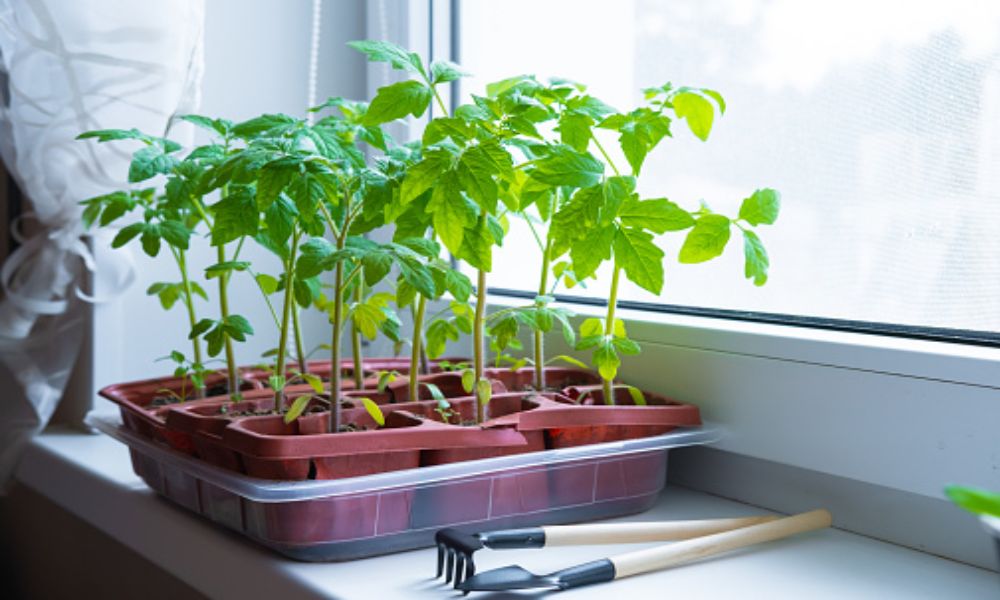When I first tried to grow herbs on my windowsill, I had no fancy grow lights—just a few seeds, a sunny spot, and a lot of curiosity. I remember thinking, “Do I need a grow light to start seeds indoors?” Turns out, you really don’t. If you’ve ever wondered how to start seeds indoors without grow lights, I’ve been right where you are. In this guide, I’ll show you how I did it—step by step—using natural light, a few clever tricks, and zero expensive gear. Let’s get your indoor garden growing the simple, budget-friendly way!
Do I Really Need a Grow Light to Start Seeds Indoors?
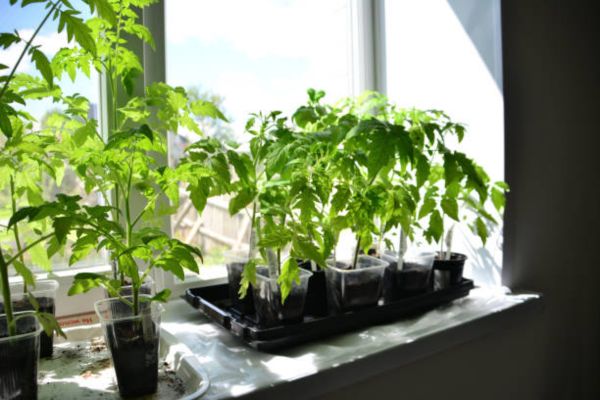
No, you don’t always need a grow light to start seeds indoors.
When I first started, I used a sunny window. That’s it. No special tools, no fancy lights. And you know what? My seeds still grew just fine.
If your home has a bright, south-facing window, you already have what you need. Sunlight can give your seeds 6–8 hours of natural light a day. That’s often enough for strong, healthy growth.
But in colder places or dark homes, grow lights can help. If you live in a northern USDA zone (like 4, 5, or 6), winter light can be weak. That’s when seeds may grow tall and thin—called “leggy.” A simple light can fix that.
If you’re planning to upgrade later, check out my guide on the best grow light for Meyer lemon tree — it works great for seedlings too!
Best Conditions for Starting Seeds Without Grow Lights
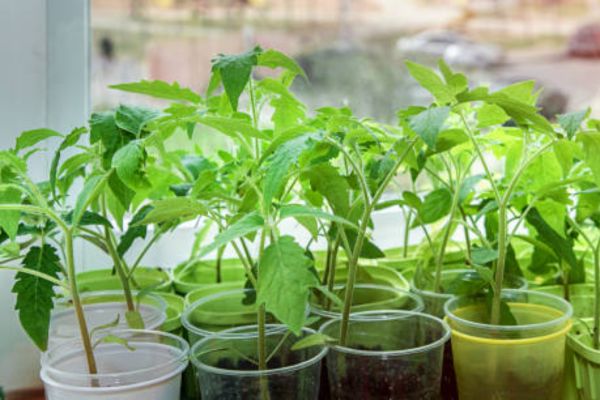
If you’re wondering what is the best way to start seeds indoors, the answer is simple: give them the right light, warmth, and soil—even without a grow light. Here’s how I do it, using everyday items around the house.
Sunlight: Your Natural Grow Light
Sunlight can do the job just fine. I place my seed trays next to a bright, south-facing window. A glass door works too. The more direct light, the better.
Aim for 12 to 16 hours of light each day. Most homes won’t get that much naturally, so I use a trick—reflectors. I tape white cardboard behind the trays to bounce light. You can also use foil. It helps spread the light and keeps the seedlings growing straight.
Room Temperature & Humidity
Seeds like it warm. The best room temperature for germination is between 65°F and 75°F. A cozy kitchen or laundry room often works great.
To keep the air moist, I make DIY humidity domes. I cover the trays with clear plastic wrap or reuse old salad containers. This traps warmth and moisture, just like a mini greenhouse.
Seed-Starting Soil and Containers
Use light, fluffy seed-starting mix. It drains well and gives roots room to grow. Avoid heavy garden soil—it holds too much water and can smother seeds.
For containers, I upcycle what I already have—egg cartons, yogurt cups, even takeout boxes. Just make sure to poke a few holes in the bottom for drainage.
How to Start Plants from Seeds Indoors (Without Lights)
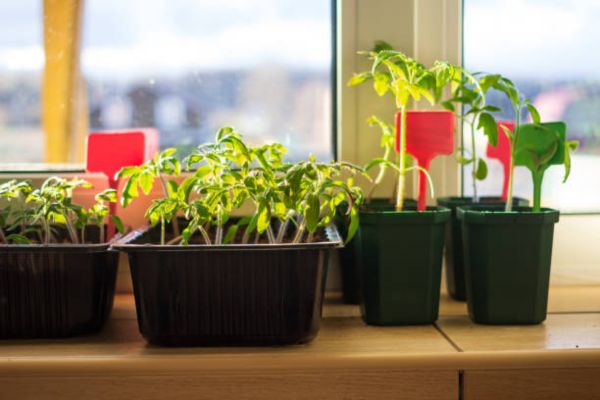
Wondering how to start plants from seeds indoors without a grow light? Here’s my step-by-step process that works—no fancy tools, no stress. Just natural light, some care, and a little patience
Step-by-Step Guide
- Choose the right seeds.
Start with easy growers like herbs, lettuce, tomatoes, or zinnias. They sprout fast and don’t need intense light.
Pre-moisten your soil.
Wet the mix before planting. It should feel like a wrung-out sponge—damp, not dripping. - Plant at the correct depth.
Check the seed packet for how deep to plant. Tiny seeds stay near the surface; bigger ones go a bit deeper. - Cover to keep humidity in.
Use plastic wrap, a clear lid, or an old salad container. This helps the seeds stay warm and moist. - Place near a bright window.
A south-facing window is best. The more sun, the better your seedlings will grow. - Rotate trays daily.
This keeps your plants from leaning too much toward the light. - Keep soil moist but not soggy.
Water gently when the surface feels dry. Bottom watering works great to avoid damping off. - Remove covers once seeds sprout.
Let them breathe fresh air to avoid mold or weak stems. - Harden off before transplanting.
A week before moving outdoors, give them time to adjust. Start with one hour of outside shade, then increase a little each day.
Real-life tip:
I once grew an entire tray of basil and marigolds right on my kitchen windowsill—no grow lights, no gadgets. Just good timing, daily rotation, and a warm, sunny spot. They turned out strong, green, and ready for my balcony garden.
Troubleshooting Common Problems
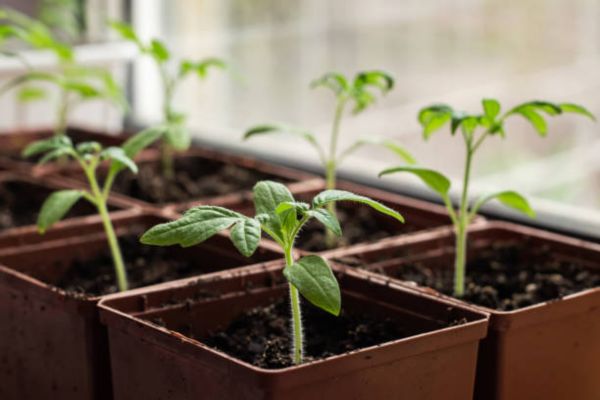
Even without grow lights, starting seeds indoors can go smoothly. But now and then, things don’t go as planned. Don’t worry—most issues have quick fixes. Let’s walk through the most common ones I’ve faced (and solved!).
Seedlings too leggy or pale?
This is super common when light comes from one side—like a window. The stems stretch too far and look weak. Fix it by giving more light. Move them closer to the window. Add a white board or foil to reflect sunlight back.
And don’t forget: Rotate your trays once a day. That keeps growth even and prevents bending.
Mold on the soil?
A thin layer of white fuzz is often harmless, but it’s a sign you need more air. Open the covers once seedlings sprout. Try bottom watering—pour water into the tray instead of on top of the soil.
Also, avoid overwatering. The surface should be damp—not soaked.
Not germinating?
Sometimes seeds just sit there and do nothing. I’ve had that happen too. Start by checking the seed packet—expired seeds may not sprout.
Next, check if you planted too deep. Most seeds only need a light cover of soil. Finally, make sure your room stays between 65°F and 75°F, especially at night. Cold soil slows everything down.
My Favorite Indoor Seed-Starting Hacks (No Grow Light Needed)
Over the years, I’ve picked up a few tricks to make indoor seed starting easier—and way more fun. These simple hacks help your seedlings grow strong, even without a grow light. Most of them cost nothing and use things you already have at home.
Use Reflectors to Boost Light
I often use a piece of white cardboard or a cheap mirror behind my seed trays. This helps reflect light back onto the plants and keeps them growing straight instead of leaning. Even foil taped to a cereal box works wonders.
Rotate Trays Every Day
Seedlings naturally reach for the light. If you don’t rotate the tray, they’ll bend. I simply give mine a quarter turn each morning. It takes 2 seconds, and it makes a big difference.
DIY Heat Mat = Top of the Fridge
You don’t need to buy a seedling heat mat. Most seeds sprout faster with gentle warmth. I place my tray on top of the fridge for the first few days. It stays warm but not too hot—just right for waking up sleepy seeds.
When to Transplant Your Seedlings
One of the most exciting moments in indoor gardening is moving your little plants outside. But how do you know when they’re ready?
Signs Your Plants Are Ready to Move
You’ll notice real leaves (not just the first baby ones) and thicker stems that don’t flop over. They should look sturdy and well-rooted. If roots are peeking out the bottom of the container, that’s another sign it’s time to move.
How to Harden Off Seedlings Gently
Plants grown indoors aren’t used to wind, sun, or temperature swings. If you move them outside too fast, they can get shocked or sunburned. This step is called hardening off, and it’s super important.
My Easy Transition Method
I start simple: one hour outside in partial shade on day one. I pick a spot that’s warm but not windy. Each day, I add an hour and move them into more sun. By the end of the week, they’re soaking up full sun for 6+ hours and loving it.
Once they’ve made it through that adjustment, I know they’re strong enough for the garden or pots on my balcony.
FAQs
What’s the best window direction for starting seeds?
A south-facing window is best. It gives the most sunlight during the day, which helps your seeds grow strong.
Which seeds grow well without grow lights?
Leafy greens, herbs, and fast-growing flowers like marigolds and tomatoes do great in natural light.
How do I prevent my seedlings from getting leggy?
Turn the tray every day so plants grow straight. You can also place white cardboard or foil behind them to reflect light.
How warm should my house be to start seeds?
Most seeds sprout best at 65°F to 75°F. Keep them in a warm spot, like the kitchen or near a heater (but not too close!).
Final Thoughts
You don’t need grow lights or a big budget—just sunlight, patience, and the right method. I’ve learned that with a little care and creativity, seeds can thrive right on your windowsill. It’s not about having all the gear—it’s about using what you already have and making it work.
Every home is different, and that’s okay. Some seeds might sprout fast, others may take their time. So don’t be afraid to experiment. Try new setups, move trays around, and see what works best in your space. That’s part of the fun!

